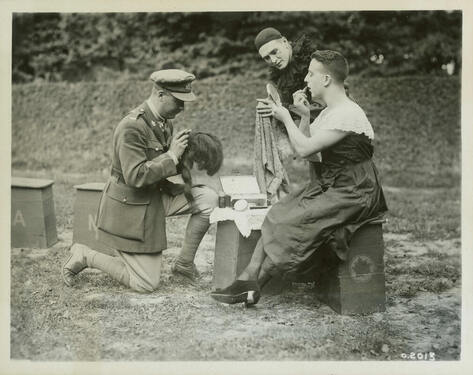Drag
 The word drag comes to English almost unchanged from its Proto-Indo-European (PIE) origins in dhregh (to draw, to drag on the ground). Over the centuries the word drag has been used in many ways.
The word drag comes to English almost unchanged from its Proto-Indo-European (PIE) origins in dhregh (to draw, to drag on the ground). Over the centuries the word drag has been used in many ways.The use of drag in the sense of women’s clothing worn by a man is from British theatre slang of the 19th century; i.e., from long skirts trailing or dragging on the floor. One suggested source of this meaning of the word drag is from German tragen (to wear).
During both World Wars One and Two, male soldiers routinely dressed as women in theatrical and musical programs designed for the entertainment of the all-male military camps (even for morale-boosting shows staged in prisoner-of-war camps). The term ‘drag queen’ is from 1941.
For example, beginning in 1916, World War One military authorities were encouraging and organizing concert parties for the soldiers during their periods of rest. By war’s end, almost every division had its own entertainment troupe, as well as performers in many of the units and formations. Soldiers were entertained by songs, skits, and cross-dressing vaudeville acts. One of the most well-known groups was the Dumbells, a troupe of Canadian soldier entertainers which continued to perform in various manifestations until 1955.
In the early 1960s, my parents went to a Hallowe’en party organized by their square dance club. My mom dressed as a man and my dad dressed as a woman. No one recognized them at the party. They won First Prize for best costumes!
In brief, “Drag performers are artists and entertainers, so being in drag is not an integral part of their identity in the same way that gender is. On the other hand, when a transgender person comes out and asks people to use a different name and different gender pronouns to refer to them, it is not part of a performance” (National Center for Transgender Equality, 2017).
Other uses of the word drag include:To draw (or walk) along slowly, 1580s.To move heavily or slowly, to hang with its weight while being moved, 1660s.Anything attached to a moving body that retards its progress, 1708.A device to stop the rotation of wheels, 1795.An annoying or boring person or thing, “What a drag!”, 1813.The ‘main drag’; i.e., the main street, 1851.A drag-out or drag-down violent fight, 1859.To take a puff on a cigarette, 1914.Thieves’ slang for an automobile, from the sense of dragging a wagon or buggy, 1935; hence, drag racing, 1947.To drag one’s feet, to delay deliberately, 1946.
Image: Members of the World War One Dumbells troupe preparing for a show
Reference: Online Etymological Dictionary, https://www.etymonline.com/
https://transequality.org/issues/resources/understanding-drag
https://www.warmuseum.ca/firstworldwar/history/life-at-the-front/trench-culture/concerts-and-theatre/
https://transequality.org/issues/resources/understanding-drag
Published on September 11, 2023 07:54
No comments have been added yet.



